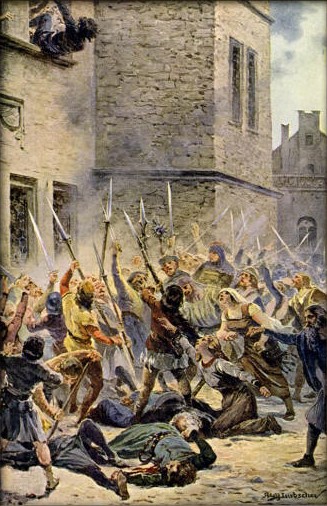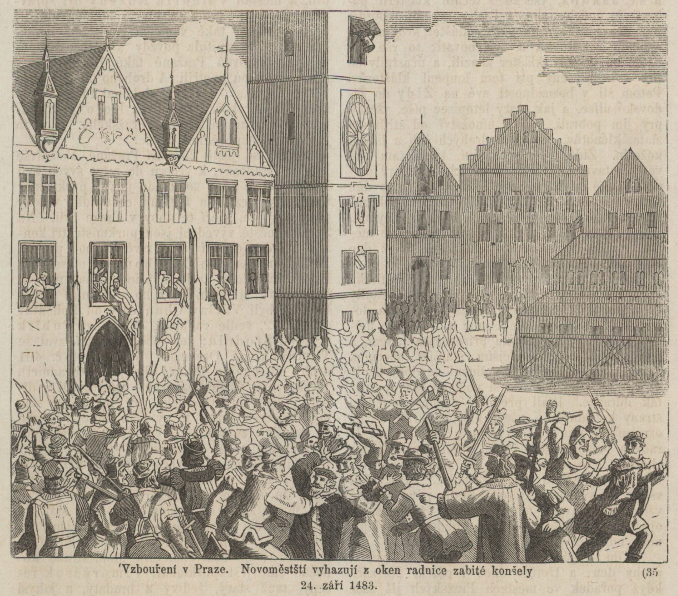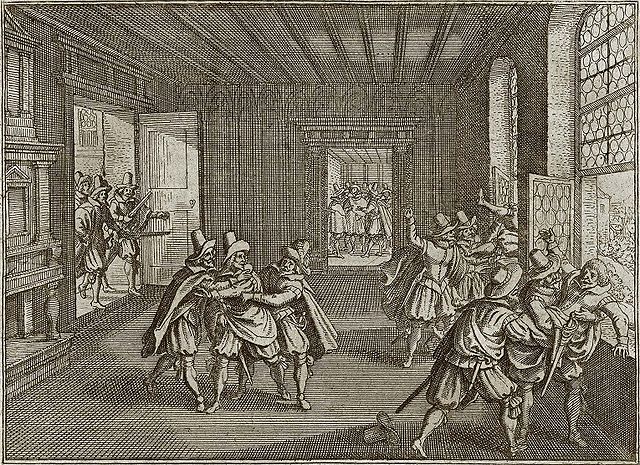If you know European history, you might be familiar with the phrase “defenestration of Prague”, as the event that sparked the Thirty Years’ War in 1618. However, there were curiously multiple similar incidents that happened in the same city throughout the centuries.
First of all, let’s define what a “defenestration” is. The term means “throwing out of a window” and comes from the Neo-Latin de- (out or from) and fenestra (window). While the word originates from the 1618 event, the act of defenestrating someone has ancient origins, being even mentioned in the Bible. Notable defenestrations happened mostly in Europe since the Late Middle Ages, with the most famous cases being the incidents in Prague.
The first defenestration of Prague (1419)
The first defenestration of Prague happened in the context of the protests following the death of early Christian reformer Jan Hus, a Czech theologian who harshly criticized the Catholic Church. In 1415, the Council of Constance condemned Jan Hus for heresy and executed him, causing massive anger in Bohemia.
On July 30, 1419, Hussite priest Jan Želivský was leading a procession of his faithfuls through the streets of Prague, to protest against the city council that refused an exchange of Hussite prisoners. During the demonstration, a stone was thrown from the town hall and allegedly hit Želivský. The enraged Hussites then stormed the building and defenestrated several members of the city council, including the judge and the burgomaster, killing them.
When King Wenceslaus IV of Bohemia heard the news, he was supposedly so shocked that he died shortly after. A series of unrests followed the death of the king, leading to the start of the Hussite Wars, which lasted until 1434 and resulted in Catholics and moderate Hussites defeating the more radical members of the movement. The 1419 defenestration is considered the casus belli and the start of the Hussite Wars.
Depiction of the first defenestration of Prague by Czech painter Adolf Liebscher.
The second defenestration of Prague (1483)
The tensions between Catholics and radical Hussites didn’t end after the Hussite Wars. Moderate Hussite George of Poděbrady was King of Bohemia between 1458 and 1471, and was succeeded by the Catholic Vladislaus II. The new king replaced the Hussite members of town councils with Catholics. On September 24, 1483, people in Prague rose up attacking the town halls of the Old and New Town, defenestrating and killing the burgomaster and various council members.
The revolt resulted in Vladislaus II ending his pro-Catholic policy, and led to the religious peace of Kutná Hora, which was signed in March 1485 and declared that the Utraquist Hussite and Catholic faiths were equal and both noblemen and commoners were free to adhere to either.
Depiction of the second defenestration of Prague from the book Česko-moravská kronika.
The third defenestration of Prague (1618)
The most famous defenestration of Prague is without a doubt the incident in 1618 that sparked the Thirty Years’ Wars. This event is again rooted in religious disputes between different Christian branches. The Peace of Augsburg of 1555 declared that the rulers of the states of the Holy Roman Empire could decide the faith of their subjects. However, in Bohemia, the Catholic Habsburg rulers did not force their faith on the majority Protestant population. In 1609, Holy Roman Emperor Rudolf II signed the Letter of Majesty, which granted tolerance to both Catholics and Protestants living in the estates of Bohemia.
The successor of Rudolf II was Matthias, who was without heirs and had his cousin, the Catholic Ferdinand of Styria (later Emperor Ferdinand II) elected to King of Bohemia and Hungary. The Protestant leaders of Bohemia feared they would lose the rights granted by Rudolf II, and preferred the Protestant Frederick V of the Palatinate as possible successor. Ferdinand promised to respect the Letter of Majesty, but Catholics and Protestants had different interpretations of the ruling, leading to a series of disputes on the construction of churches.
On May 23, 1618, a group of Protestant nobles met with the Catholic representatives sent by Ferdinand. The meeting ended with two Catholic hard-liners and their secretary being thrown out of a window of the Prague Castle. Despite a fall of about 20 meters, all three survived, and Catholics claimed they were saved by divine intervention.
After the incident, both Protestant and Catholics started to raise armies, leading to the Bohemian Revolt. Ferdinand was removed as King of Bohemia and replaced with Frederick V of the Palatinate. The imperial forces eventually defeated the revolt, but the conflict spread throughout Europe and led to the Thirty Years’ War, one of the longest and bloodiest wars in the history of the continent. The conflict ended with the Peace of Westphalia in 1648 which, among various agreements, mostly confirmed the Peace of Augsburg of 1555, with the added provision that if a ruler changed religion, the subjects were not forced to follow suit.
Depiction of the third defenestration of Prague by Swiss engraver Matthäus Merian the Elder.
The fourth defenestration of Prague (1948)
The fourth defenestration of Prague is a much different story. On March 10, 1948, the Foreign Minister of Czechoslovakia Jan Masaryk was found dead under the window of the bathroom of the Ministry of Foreign Affairs in Prague. Officially reported as a suicide, it was widely believed that Masaryk was thrown out of the window either at the behest of the Communist government or by the Soviet secret services. A police report in 2004 concluded that the death of Masaryk was likely a murder. Further investigations rose doubts about these findings, but the matter was definitely shelved in 2021, citing lack of evidence to make a final determination. Despite the uncertainty, the event has been sometimes described as the “fourth defenestration of Prague”, in reference to the previous incidents.




